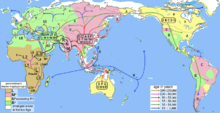In human mitochondrial genetics, haplogroup Q is a human mitochondrial DNA (mtDNA) haplogroup typical for Oceania. It is a subgroup of haplogroup M29'Q.
YouTube Encyclopedic
-
1/3Views:2 6705353 915
-
Haplogroup Q-M242
-
[Wikipedia] Haplogroup Q-M3
-
Haplogroup K (mtDNA)
Transcription
Origin
Haplogroup Q is a descendant of haplogroup M.
Distribution
Today, mitochondrial DNA Haplogroup Q is found in the southern Pacific region, especially in New Guinea, Melanesia[2] and indigenous Australians.[3] Haplogroup Q is very diverse and frequently occurring among Papuan and Melanesian populations, with an inferred coalescence time of approximately 50,000 years before present. The frequency of this haplogroup among the populations of the islands of Wallacea in eastern Indonesia is quite high, indicating some genetic affinity between the populations of these islands and the indigenous peoples of New Guinea. Haplogroup Q has also been found at higher frequencies, among modern populations of Sundaland but in moderate frequencies Micronesia, and Polynesia. In Southeast Asia it is found in lower frequencies. Malaysians 1.8%,[4] It's also found in Indonesians, Filipinos (especially in Surigaonon people it's 4.17%[5]), Balinese 1.2%, Borneans 1.3%,[6]
Subclades
Tree
This phylogenetic tree of haplogroup Q subclades is based on the paper by Mannis van Oven and Manfred Kayser Updated comprehensive phylogenetic tree of global human mitochondrial DNA variation[1] and subsequent published research.
- Q
- Q1'2
- Q1
- Q1a
- Q1b
- Q1c
- Q2
- Q2a
- Q2b
- Q1
- Q3
- Q3a
- Q3a1
- Q3b
- Q3a
- Q1'2
See also
- Genealogical DNA test
- Genetic genealogy
- Human mitochondrial genetics
- Population genetics
- Human mitochondrial DNA haplogroups
|
Phylogenetic tree of human mitochondrial DNA (mtDNA) haplogroups | |||||||||||||||||||||||||||||||||||||||
| Mitochondrial Eve (L) | |||||||||||||||||||||||||||||||||||||||
| L0 | L1–6 | ||||||||||||||||||||||||||||||||||||||
| L1 | L2 | L3 | L4 | L5 | L6 | ||||||||||||||||||||||||||||||||||
| M | N | ||||||||||||||||||||||||||||||||||||||
| CZ | D | E | G | Q | O | A | S | R | I | W | X | Y | |||||||||||||||||||||||||||
| C | Z | B | F | R0 | pre-JT | P | U | ||||||||||||||||||||||||||||||||
| HV | JT | K | |||||||||||||||||||||||||||||||||||||
| H | V | J | T | ||||||||||||||||||||||||||||||||||||
References
- ^ a b van Oven, Mannis; Manfred Kayser (13 Oct 2008). "Updated comprehensive phylogenetic tree of global human mitochondrial DNA variation". Human Mutation. 30 (2): E386–E394. doi:10.1002/humu.20921. PMID 18853457. S2CID 27566749.
- ^ mtDNA Haplogroup Testing Archived 2006-12-14 at the Wayback Machine
- ^ Hudjashov, Georgi et al 2007, Revealing the prehistoric settlement of Australia by Y chromosome and mtDNA analysis.
- ^ Complete mtDNA genomes of Filipino ethnolinguistic groups: A melting pot of recent and ancient lineages in the Asia-Pacific region, by Catherine Hill, A Mitochondrial Stratigraphy for Island Southeast Asia
- ^ Complete mtDNA genomes of Filipino ethnolinguistic groups: A melting pot of recent and ancient lineages in the Asia-Pacific region, by Frederick Delfin, https://www.researchgate.net/publication/237147028_Complete_mtDNA_genomes_of_Filipino_ethnolinguistic_groups_A_melting_pot_of_recent_and_ancient_lineages_in_the_Asia-Pacific_region
- ^ Complete mtDNA genomes of Filipino ethnolinguistic groups: A melting pot of recent and ancient lineages in the Asia-Pacific region, by Catherine Hill, A Mitochondrial Stratigraphy for Island Southeast Asia
External links
- General
- Mannis van Oven's Phylotree
- Haplogroup Q
- Ian Logan's Mitochondrial DNA Site: Haplogroup Q
- Ian Logan's Mitochondrial DNA Site: Haplogroup Q2
- Ian Logan's Mitochondrial DNA Site: Haplogroup Q3
- YFull MTree's Haplogroup Q
- MITOMAP's Haplogroup Q

